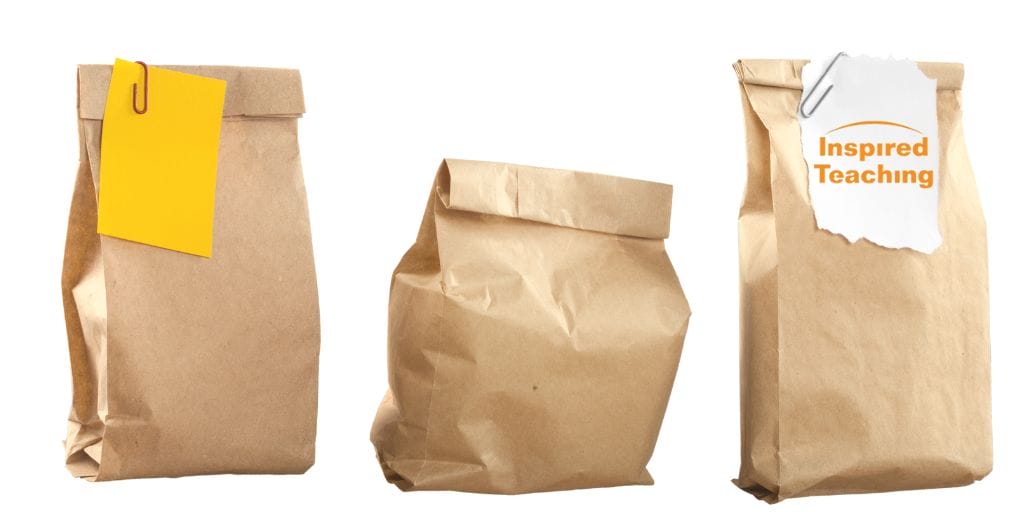The following activity is part of a series we’re creating to support students, teachers, and caregivers, during this unprecedented time. Read more about the project here. If you try this activity with your student(s), we’d love to see what you do. Share your journey via the #Inspired2Learn hashtag on your preferred social platform.
Created by: Judy White and Nathan Liang
Discipline: Logic, storytelling, could be any discipline based on the items you choose
Age level: early childhood, and up
Time: 5 minutes to as long as you want
Materials: Brown paper bag (or any kind of bag); household items that fit inside the bag – a favorite sock, a coffee mug, your teddy bear, a hair tie, an old earring, an apple core, a coin, a bar of soap, a salt shaker, a dried flower, etc.
What to do:
- Player A secretly places an item in the bag, outside of view of Player B.
- Player B begins by asking, “What’s in the bag?”
- Player A responds with an identifying detail; then Player B crafts a new question based on Player A’s response, and the game continues.
Here’s how the game might work when an or older player engages with a young child:
Player A (adult/older child) secretly places a sock belonging to Player B (young child) in the bag.
Player B: What’s in the bag?
Player A: Something you wear.
Player B: Where does it go?
Player A: On your feet?
Player B: Is it a shoe?
Player A: No! Feel the bag; it’s much lighter than a shoe!
Player B: Is it my tan sock?
Player A: Yes!
Here’s how the game might work, with the same tan sock, when both players are elementary school aged or older:
Player A secretly places a sock belonging to Player B in the bag.
Player B: What’s in the bag?
Player A: Something that’s part of a set.
Player B: How many other things are usually included in the set?
Player A: Just one other, so it’s part of a pair.
Player B: What’s it used for?
Player A: Keeping two sets of five warm.
Player B: Is it a sock?
Player A: Yes! But which one?
Player B: Is it one that we couldn’t find yesterday when we were folding laundry?
Player A: Yes!
Player B: Is it my tan sock?
Player A: Yes!
The game can be repeated over and over with different objects, and with Players A and B switching roles.
This game is quite simple – all that’s required is that Player A places an object in the bag and Player B asks questions in a quest to discover what it is. Both players can determine how challenging they want the activity to be. For instance, in response to the question, “What’s in the bag?” Player A could simply have responded, “Your tan sock!” and the round would have ended. Or, if the goal were to make the game far more challenging, Player A could have responded, “Something made of molecules,” and taken the game in an entirely different direction.
Extensions:
Challenge yourself and your teammate to make the game last only one question (i.e. “What’s in the Bag?” “Your tan sock!”) Then try making the game last for only two questions. Then three, four, five, etc. See if you can make the game last exactly ten questions. What kinds of skills does it take to get to the answer in exactly 10 questions?
What might happen if you play the game several times with the same object? How might the purpose of the game change, and what skills might be required to play, if the object inside the bag is known in advance by both players.
In this time of high stress and unwelcome surprises, after you’ve played the game a few times, consider putting something in there that is a special treat for the person you are playing with. In this context the play might look like:
Player A: You are four. So, clap how many times have we played this?
Payer B: Four claps.
Player A: So, today is a special day for “What’s in a bag.” There’s a surprise for you in the bag. Now, start guessing . . .
Inspired Teaching connection:
In this activity, both players strengthen their ability to craft questions aimed at reaching a specific goal (to figure out a characteristic of the item in the bag). Learning how to ask the right question is key to Inquiry and guessing what’s in the bag also taps into Imagination (two of Inspired Teaching’s 4 I’s). And when you mix the game up and add in a special surprise for the person you are playing with, you’ll experience Joy, one of our Core Elements, and something we can all use a lot more of right now.
See our instructional model here.

